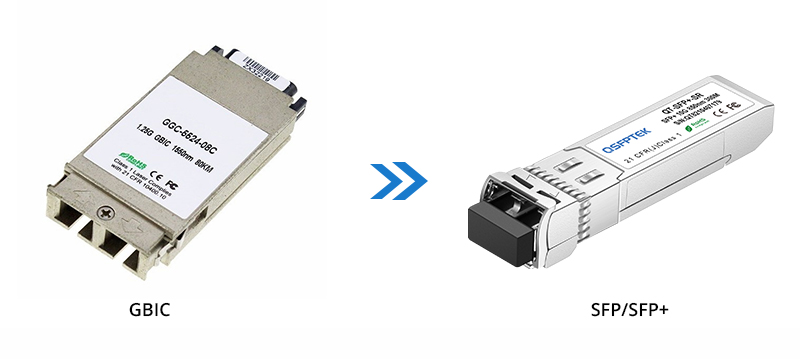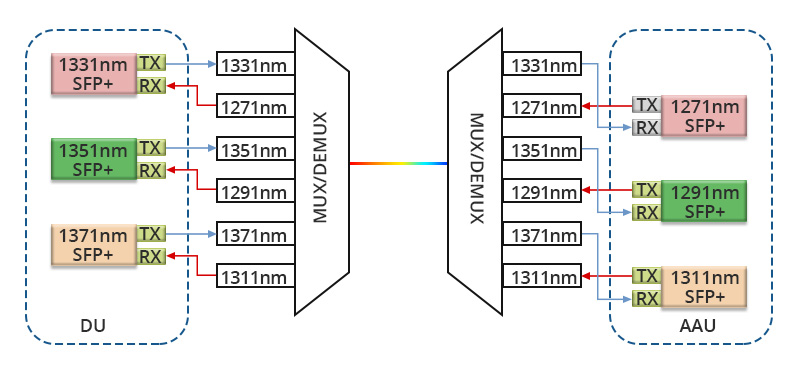SFP28 vs SFP+, What Are the Differences?
SFP28 vs SFP+ - Explore SFP+
SFP+ means enhanced small form-factor pluggable, which is an enhanced version of the SFP. They have the same size and appearance and replace the formerly common gigabit interface converter (GBIC). SFP+ is standardized by the SFF-8431 and supports 10-Gigabit Ethernet and 10-Gigabit Infiniband standards. SFP+ series transceivers support the link length from 30m to 100km. With the advantages of small form factor size, lower power consumption rate, and low cost, SFP+ optical modules have become the most popular 10 Gigabit Ethernet module in the market.

Fig. 1 - GBIC Transceivers Upgrade to SFP/SFP+ Transceivers
SFP28 vs SFP+ - Explore SFP28
SFP28 is the standardized pluggable form factor for 25G transceivers. It has the same mechanical dimensions as 10G SFP+, but its electrical interface is upgraded to handle 25 Gbps per lane. SFP28 is an enhanced version of SFP+, compliant with IEEE 802.3by and IEEE 802.3cc. SFP28 ports in switches and routers are compatible with both SFP and SFP+ transceivers. 25G SFP28 transceiver offers customers a wide variety of high-density and low-power 25G Ethernet connectivity options for data center and high-performance computing network applications. It is also applicable in the coming 5G fronthaul networks as the mainstream optical modules solution, as shown in Fig. 2.
See more about 25G SFP28 CWDM application in 5G fronthaul.

Fig. 2 - 25G SFP28 CWDM Transceivers Applicated in 5G Fronthaul
SFP28 vs SFP+ - Key differences between SFP+ and SFP28
1. The Transmission Data Rate Difference Between SFP+ and SFP28
SFP+ transceivers are designed to operate at 10G, whereas SFP28 transceivers are dual-rate transceivers that support both 10G and 25G data rates. SFP28 is backward compatible with SFP+ ports and can be fully functional at 10G. However, SFP+ optical transceivers can be plugged into the SFP28 ports, but can't support a 25G data rate.
2. The Transceiver Structure Difference Between SFP+ and SFP28
Compared with the 10G SFP+ modules structure, 25G transceivers newly added CDR (Clock Data Recovery) circuits to deal with the data rate increase from 10Gbit/s to 25Gbit/s, as shown in Fig.3.

Fig. 3 - 25G SFP28 Working Principle
3. The Max Transmission Distance Between SFP+ and SFP28
Due to the dispersion tolerance of SFP28 being decreased than SFP+, SFP28 supports the maximum transmission distance at 40km only while SFP+ supports link length up to 120km.
SFP28 vs SFP+ - Advantages of SPF28
Enhanced Performance of 25G SFP28. 25G SFP28 module offers 2.5 times the bandwidth with heavier port density. It also enables a low consumption and excellent thermal dispersion performance based on the mature chip technology.
Broader Range of Applications of 25G SFP28. 25G SFP28 modules enable a 50G transfer data rate with only 2 channels while 10G SFP+ modules achieving 40G transfer data rate need four channels of 10G speed. It is obvious that the 25G SFP28 transceiver is the better choice for the upgrade of the 10-Gigabit Ethernet. Moreover, 25G SFP28 is also the mainstream optical module solution for 5G fronthaul.
Cost-effective Upgrade Path of SFP+ to SFP28. Compared to the 40G QSFP28 solution, 25G SFP28 transceiver enables higher port density, lower power consumption, and lower costs. Moreover, the upgrade from 10G to 25G still follows the current photoelectricity technology and infrastructure, which reduces the costs to the utmost extent. The server upgrade path of 10G-25G-100G-400G has been commonly accepted by the industry.
Conclusion
25G SFP28 not only stands out in data rate performance but also saves system power and costs. Though the SFP+ port still dominates the market, the SFP28 port shipment does increase YoY. SFP28 optics may be the ideal solution to migration from 10G to 40G, 100G, or higher speed access.
QSFPTEK 25GBASE SFP28 modules portfolio offers customers a wide variety of high-density and low-power 25 Gigabit Ethernet transceiver connectivity options with assured quality and best price as below. Welcome inquiry at [email protected].
Table 1 - QSFPTEK 25G SFP28 Series Fiber Optic Transceivers Spec
| Transceiver Type | Wavelength | Cable Type | Cable Distance | Max Power Consumption |
| SFP-25G-SR-S | 850nm | MMF | 70/100m (OM3/OM4) | 1.2W |
| SFP-10/25G-CSR-S | 850nm | MMF | 300/400m (OM3/OM4) | 1.2W |
| SFP-25G-LR | 1310nm | SMF | 10km | 1.3W |
| SFP-25GBX-D-10 | 1330nm | SMF | 10km | 1.5W |
| SFP-25GBX-U-10 | 1270nm | SMF | 10km | 1.5W |
| SFP-25G-ER | 1330nm | SMF | 40km | 1.5W |
|
|
1270nm-1370nm | SMF | 10km | 1.3W |










